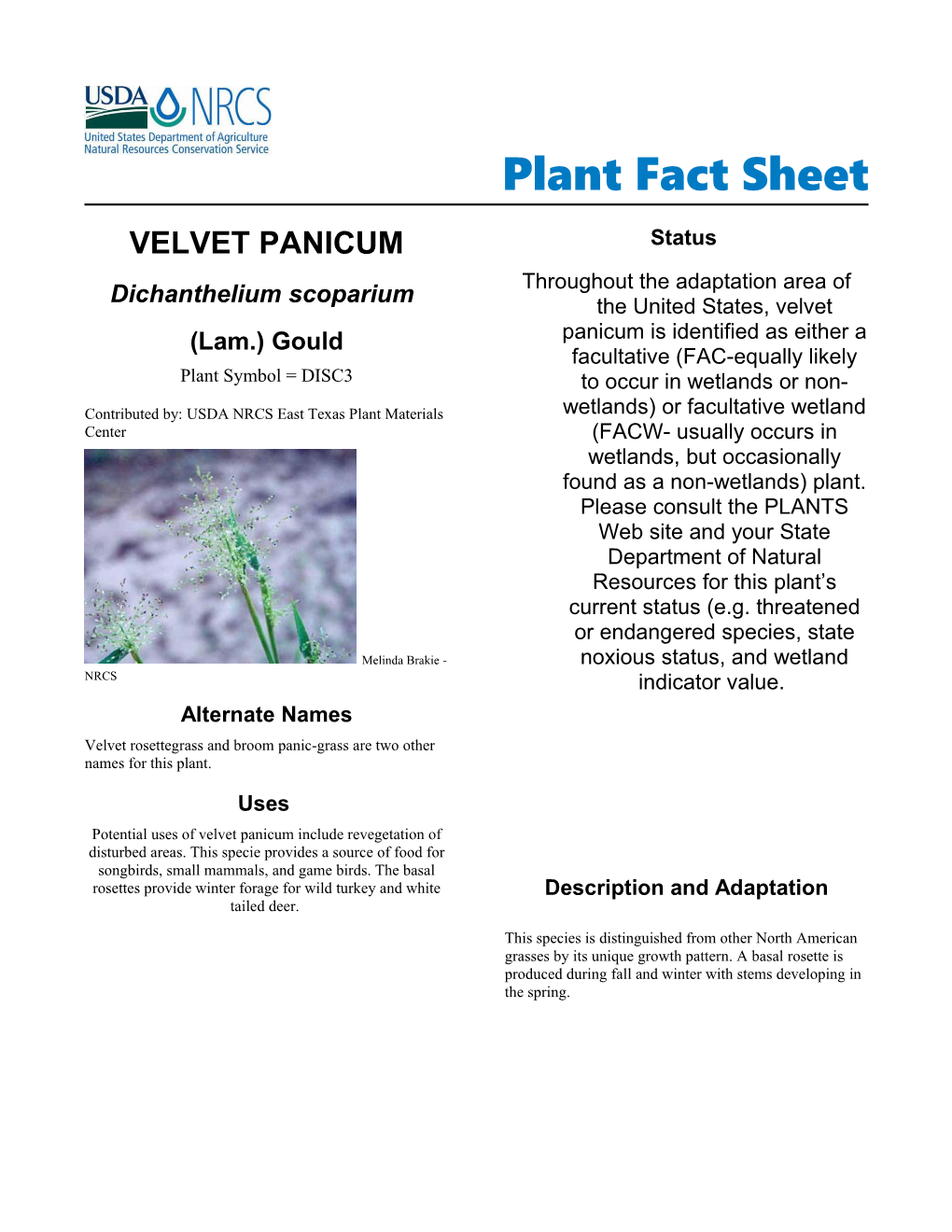Plant Fact Sheet
velvet panicum
Dichanthelium scoparium
(Lam.) Gould
Plant Symbol = DISC3
Contributed by: USDA NRCS East Texas Plant Materials Center
Melinda Brakie - NRCS
Alternate Names
Velvet rosettegrass and broom panic-grass are two other names for this plant.
Uses
Potential uses of velvet panicum include revegetation of disturbed areas. This specie provides a source of food for songbirds, small mammals, and game birds. The basal rosettes provide winter forage for wild turkey and white tailed deer.
Status
Throughout the adaptation area of the United States, velvet panicum is identified as either a facultative (FAC-equally likely to occur in wetlands or non-wetlands) or facultative wetland (FACW- usually occurs in wetlands, but occasionally found as a non-wetlands) plant. Please consult the PLANTS Web site and your State Department of Natural Resources for this plant’s current status (e.g. threatened or endangered species, state noxious status, and wetland indicator value.
Description and Adaptation
This species is distinguished from other North American grasses by its unique growth pattern. A basal rosette is produced during fall and winter with stems developing in the spring.
Winter basal rosette
Velvet panicum is a native perennial bunchgrass that actively grows during the summer. However, the plant’s lifespan is considered to be short when compared to other perennial plants. It has erect coarse stems up to 4.5 feet tall. The gray-green stems and leaves are covered with fine hairs. The leaves are .25 to 1.0 inch wide. Velvet panicum tends to flower later than the other Dichanthelium species if they are present in a stand.There are approximately 380,000 seeds per pound.
Velvet panicum is adapted to the eastern United States from New York to Florida west to Kansas and Texas. In East Texas, this plant is predominantly found in woods and post oak savannahs. This adaptation area corresponds to USDA Hardiness Zones 5b to 10b. Velvet panicum grows in areas with precipitation ranging from 30 to 55 inches. It prefers coarse and medium textured soils with pH range of 4.5 to 7.5. Velvet panicum is not tolerant of salinity. This plant is found in sandy woods, low areas, and disturbed sites.
Establishment
Fertilize planting area according to soil test for establishment. Maintain fertility levels at medium conditions and soil pH near 6.0. To reduce weed competition, do not over apply nitrogen.
Plant the seed at a rate of 3.0 pure live seed pounds per acre in the fall when the ground is moist. Drill or hand plant seeds at a depth of ½” or less. If broadcasting, use a cultipacker to increase seed to soil contact.
Management
If managing as a planting: Do not over apply nitrogen fertilizer or keep soil fertility at a high level. Seed production maybe decreased by high fertility levels. When managing for seed production, mow in the spring to clip off previous year’s growth.
Summer seed harvest is completed using a flail vac or combine. The flail vac harvests the mature seed without harming the plants; therefore multiple harvests can be completed on the same seed production field. At the East Texas PMC, summer flail vac harvesting produced 60 pounds of cleaned seed per acre.
The fall produced seeds are found in the spikelet sheath and can be harvested with a combine.
Seed is cleaned using a two screen air seed cleaner with a 6/64 top screen and a 1/23 bottom screen with very little air flow.
Pests and Potential Problems
If managing for seed production, velvet panicum will hybridize with tapered rosettegrass (D. acuminatum) and cypress panicgrass (D. dichotomum).
Environmental Concerns
This plant is considered an endangered species in Indiana. Please consult the PLANTS Web site and your State Department of Natural Resources for this plant’s current status (e.g. threatened or endangered species, state noxious status, and wetland indicator values).
Control
Velvet panicum spreads slowly by seed. Please contact your local agricultural extension specialist or county weed specialist to learn what works best in your area and how to use it safely. Always read label and safety instructions for each control method.
Cultivars, Improved, and Selected Materials (and area of origin)
Pilgrim Germplasm velvet panicum (D. scoparium), released in 2007 by the East Texas Plant Materials Center, is a selected class for wildlife and critical area seedings. The intended area of use for this release is the southeastern United States.
Prepared By
Melinda Brakie, East Texas Plant Materials Center
Citation
Brakie, M. 2007. Plant fact sheet forvelvet panicum
Dichanthelium scoparium (Lam.) Gould. USDA-Natural Resources Conservation Service, East Texas Plant Materials Center, Nacogdoches, TX 75964.
Published September 2007
Edited: 120911mb
For more information about this and other plants, please contact your local NRCS field office or Conservation District and visit the PLANTS Web site or the Plant Materials Program Web site <
USDA IS AN EQUAL OPPORTUNITY PROVIDER AND EMPLOYER
